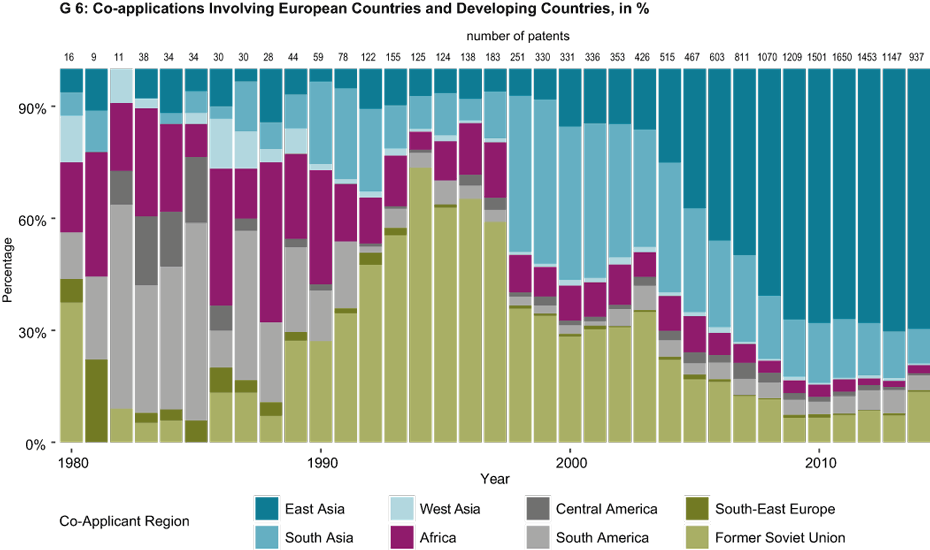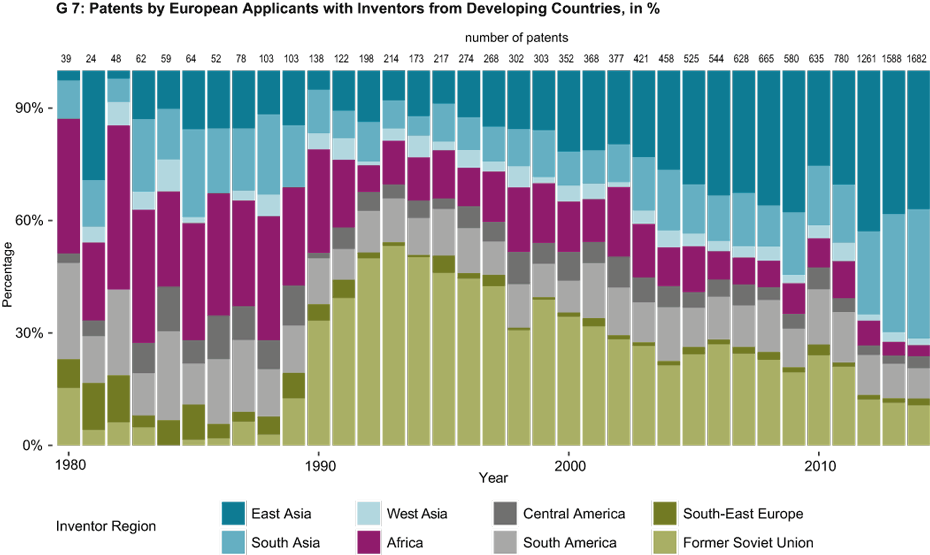Sources of Knowledge Flow Between Developed and Developing Nations
- Innovation
- KOF Bulletin
What is the trend in research and development (R&D) collaboration and technology sourcing between developed and developing nations? A new study shows that Europe is lagging behind the USA when it comes to the number of collaborations with developing nations

The research1 conducted by the authors Gaétan de Rassenfosse and Florian Seliger is based on data quantifying joint regional patent activities (e.g. Europe in conjunction with South-East Asia). According to the data, there is a pronounced concentration of technological activities in the field of information and communication technology (ICT) by European and North American countries in conjunction with China on the one hand and with developing nations on the other.
Cross-border knowledge flow can expand knowledge bases in developing nations
Emerging markets must catch up in the technological field if they want to follow higher technological development trajectories. However, the facilitation of learning processes, for instance, requires sufficient knowledge bases and infrastructure in the ‘learning’ countries (e.g. in the form of universities and highly-qualified engineers). Since collaboration involving individuals or companies generates knowledge flows between the parties involved, knowledge flows may, for instance, be expected to arise between Switzerland and India when Swiss companies enter into collaborations with Indian companies.
Measuring R&D collaboration and technology sourcing on the basis of patent data
Patent applications contain important and useful information (applicant, patent inventor, country of residence, etc.). The authors have used this information to identify those patents that have at least one applicant from North America or Europe and at least one applicant from a developing country. Most likely, such patent applications are the result of a collaboration between companies from a western industrialised country and a developing country (so-called "co-application", see G 6).
The same procedure was applied to identify patent applications involving an applicant from North America or Europe and an inventor resident in a developing nation. Provided these applications do not simultaneously originate from a further applicant in a developing nation (and are therefore not co-applications), they may serve as an indicator of "technology sourcing" from developing nations (see G 7).
In most cases, these patent applications arise after a company from a developed nation establishes a R&D department in a developing nation, which is therefore the country of residence of the inventor. Frequently, R&D capacities are relocated to developing countries on cost grounds, although the establishment of R&D departments in industrialised countries may also result in greatly enhanced access to further local specialists. With developing nations offering large markets thanks to their growing populations, market access may be a further motive for launching local activities.
Significant rise in R&D collaborations with developing countries – especially Asia
Between 1980 and 2010, the annual growth rate of co-applications involving Europe and developing countries was 16.3% (increase to 1,501 patents), while the growth rate of co-applications involving Europe and North America was as low as 8%. However, in the latter case, the absolute numbers are still much higher (2010: 5,000 patents). Compared to the number of R&D collaborations between the USA/Canada and developing nations, such collaborations are still relatively rare between Europe and the developing nations. In 2010, the number of co-applications involving North America and developing nations was 3,829 compared to 1,501 involving Europe and developing countries. This is all the more significant since the total number of patent applications by European countries exceeds the number of applications by North American countries.
Developing countries in Asia are the most prominent collaboration partners among the emerging markets regions (G 6). A high percentage of the growth in these collaborations is driven by collaborations with East-Asian, specifically Chinese, companies. The number of R&D collaborations with Russia and former Soviet republics is low. Although collaborations have increased slightly in Africa and in Central and South America, they are still at a very low level. The share of collaborations with non-Asian countries has dropped dramatically and is now as low as 17 %.
The USA and Canada are following a similar trend to Europe, although they concentrated on Asia much earlier than Europe. On top of this, collaboration also focussed much earlier on the ICT area (USA & Canada: 29% of the collaborative patents involving developing countries were in 2000 ICT-based, Europe: 10.7% in 2000).
Substantial rise in technology sourcing in South and East Asia
In the field of technology sourcing (whereby inventors based in a research centre in a developing country work for a European company), Asian countries also dominate over all other regions (G 7). In many cases, European companies develop technologies (or have them developed) in India.
In East Asia, however, companies seem to focus more on collaborations. South Asia could offer significant cost savings, which may be one of the reasons why companies relocate their research activities to the region.
Pronounced concentration of R&D activities both in regional and technological terms – significant potential for knowledge flows between China and the USA/Canada
The authors’ analysis presents a consistent picture: First, technological activities involving developing countries concentrate significantly on East Asia and – to a slightly smaller extent – on South Asia. It may be assumed that China can benefit most from knowledge flows, while other developing countries might be crowded out of the technology race in the long term. However, since China also invests heavily in its own R&D, ‘reverse’ knowledge flows from China to established western industrialised countries should also be expected. The results furthermore indicate that technological activities involving developing countries focus on the ICT area.
While patent activities involving Europe and Asia have expanded substantially in the last few years, Asian countries, especially China, have been key technology partners for North America for a much longer period. The USA and Canada therefore stand to benefit more from knowledge originating in China ("reverse knowledge flow") than Europe.
1. The project was supported by a grant (“Globalization of R&D: Technology Cluster, Performance and Risk”) awarded by the Swiss National Science Foundation.
Literature
De Rassenfosse Gaétan, Florian Seliger (2018): Sources of knowledge flow between developed and developing nations, KOF Working Papers vol. 444, Zurich: KOF Swiss Economic Institute, ETH Zurich, 2018.
This article is a summary of a section of the Handbook on Trade in Knowledge from the World Trade Organization (edited by Jayashree Watal) that will be published shortly.
Contact
No database information available


